View in other NatureServe Network Field Guides
NatureServe
Montana
Utah
Wyoming
Idaho
Wisconsin
British Columbia
South Carolina
Yukon
California
New York
Western Azure - Celastrina echo
Other Names:
Echo Azure
General Description
Taxonomy of western North American Celastrina is in flux, with some authorities now elevating lucia, neglecta, and echo to full species, though each was a former subspecies of C. ladon; other authorities include ladon as a synonym for C. argiolus (Scott 1986; Pratt et al. 1994; Guppy and Shepard 2001; Pyle 2002; Acorn and Sheldon 2006; Schmidt and Layberry 2016). Sections of this account probably include information for more than one taxon now considered a full species.
[From Ferris and Brown 1981; Scott 1986; Opler and Wright 1999; Glassberg 2001; Guppy and Shepard 2001; Pyle 2002] Forewing 1.0-1.4 cm. Tailless, with white fringe and lacking orange markings; sexually dimorphic. Uppersurface of males unmarked blue, females blue with at least some black on outer half of forewing, hindwing with a row of black marginal spots; both sexes with undersurface of forewing and hindwing dirty chalk-white, sometimes with charcoal marginal band, hindwing with black-gray spots. [The preceding description is relatively generic.]
Phenology
One flight, mostly May in the Rocky Mountains; several fights, March to July in Oregon and California, mid-March to October in southern Nevada, February to November in New Mexico (Scott 1986). April or May to August (at higher elevations) in the Rocky Mountain states (Glassberg 2001). Late February to early October in Oregon and Washington (Pyle 2002), late January to August in Oregon (Warren 2005), early April to early August in British Columbia (Threatful 1988; Guppy and Shepard 2001).
Diagnostic Characteristics
Probably best determined from other blues by being tailless and lacking orange markings; uppersurface of males unmarked blue, females blue with at least some black on outer half of forewing, hindwing with a row of black marginal spots; both sexes with undersurface of forewing and hindwing dirty chalk-white and sometimes with charcoal marginal band, hindwing with black-gray spots, but lacking irregular disk blotch present in C. lucia.
Species Range
Montana Range
Range Descriptions
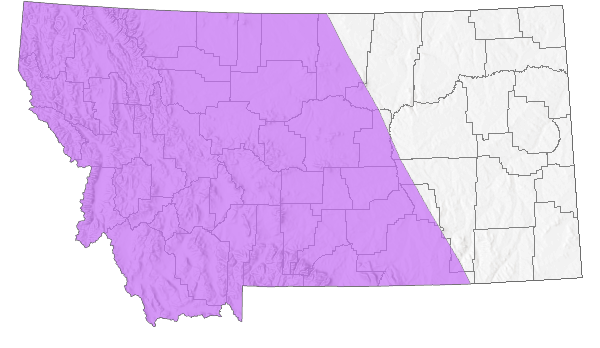
 Native
Native
Range Comments
Apparently from southern British Columbia south through California to southern Baja California, south in the Rocky Mountains through Arizona and New Mexico to northern Mexico (Pratt et al. 1994; Guppy and Shepard 2001; Pyle 2002; Warren 2005); 213 m to 1737 m elevation in Oregon (Warren 2005), 456 m to 945 m elevation in southeastern British Columbia (Threatful 1988). In Montana, C. argiolus reported from western half of state (Kohler 1980; Shepard and Opler 1993) with records of C. ladon in eastern Montana. Older reports include a mix of C. lucia, C. ladon, and C. echo; northern counties probably primarily lucia, southern counties primarily ladon, with echo across western half of state and neglecta in the eastern half (see Scott 1986; Pratt et al. 1994; Guppy and Shepard 2001; FLMNH Lepidopterists' Society database); to at least 1640 m elevation (Big Horn County). Common to abundant (Glassberg 2001), but comment pertains to lucia, ladon, and echo combined under C. ladon.
Observations in Montana Natural Heritage Program Database
Number of Observations: 41
(Click on the following maps and charts to see full sized version)
Map Help and Descriptions
Relative Density

Recency
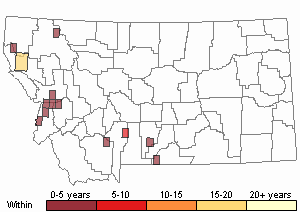
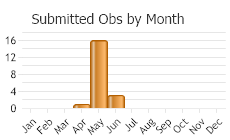
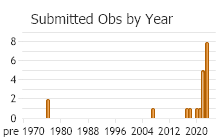
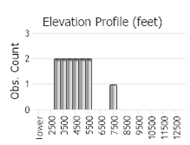 (Observations spanning multiple months or years are excluded from time charts)
(Observations spanning multiple months or years are excluded from time charts)
Migration
Non-migratory.
Habitat
Woodlands, shrublands, riparian corridors, (Scott 1986; Glassberg 2001; Pyle 2002). In northern Idaho, densities higher in forest than grasslands, with no difference between mature and young forest stands, and related overall to % cover of larval host plants (Pocewicz et al. 2009); this study probably pertains to C. echo rather than C. ladon under current classification. Habitat in Montana uncertain, in part due to taxonomic confusion, but likely similar to other areas; in Glacier National Park, C. argiolus ladon reported from montane mesic meadows (Debinski 1993), which may refer to C. echo under current classification, given the northwestern Montana locality.
Food Habits
Larval food plants diverse, including Adenostoma, Aesculus, Amelanchier, Arbutus, Baccharis, Betula, Buddleja, Ceanothus, Celastrus, Chamaebatiaria, Cornus, Diervilla, Eriodictyon, Eriogonum, Frangula, Heteromeles, Holodiscus, Jamesia, Kalmia, Ledum, Lotus, Lupinus, Petrophytum, Physocarpus, Prunus, Ribes, Rhododendron, Sambucus, Spiraea, Vaccinium, and Viburnum (Ferris and Brown 1981; Scott 1986; Pratt et al. 1994; Pyle 2002; Warren 2005; James and Nunnallee 2011). Adults feed on flower nectar (including Aesculus, Aletes, Ceanothus, Daphne, Eriodictyon, Frangula, Heteromeles, Lasthenia, Leontodon, Mertensia, Prunus, Ribes, Salix, Tussilago, Viola), cooked fish, dung, ash, and mud (Pyle 2002; James and Nunnallee 2011; Scott 2014).
Reproductive Characteristics
Probably similar to other Celastrina species. Females lay eggs singly (about 20 eggs reported for one female) deep among host plant flower buds (Scott 1986; James and Nunnallee 2011). Eggs hatch in about 2-4 days (depending on temperature). Larval development rapid, from egg to L4 instar and pupation in 12-19 days after egg-laying. Prepupal L4 instar wanders off host plant before pupating. Adults eclose (emerge) from non-diapausing pupae in 7-19 days; many overwinter as pupae and eclose in spring in about 4 days of exposure to moderate temperatures (James and Nunnallee 2011). Larvae do not build nests, may be tended by ants (Formica in captivity), eat flowers and fruits, leaves if flowers and fruits not available (Scott 1979, 1986; Ballmer and Pratt 1991; James and Nunnallee 2011). Males patrol throughout the day near and around host plants in valley bottoms, on slopes and ridges, in search of females (Scott 1975b, 1986).
Stewardship Responsibility
References
- Literature Cited AboveLegend:
 View Online Publication
View Online Publication Acorn, J. and I. Sheldon. 2006. Butterflies of British Columbia. Edmonton, Alberta. Lone Pine Publishing. pp.360
Acorn, J. and I. Sheldon. 2006. Butterflies of British Columbia. Edmonton, Alberta. Lone Pine Publishing. pp.360 Ballmer, G.R. and G.F. Pratt. 1991. Quantification of ant attendance (myrmecophily) of lycaenid larvae. Journal of Research on the Lepidoptera 30(1-2): 95-112.
Ballmer, G.R. and G.F. Pratt. 1991. Quantification of ant attendance (myrmecophily) of lycaenid larvae. Journal of Research on the Lepidoptera 30(1-2): 95-112. Debinski, D. 1993. Butterflies of Glacier National Park, Montana. Occasional Papers of the Museum of Natural History, the University of Kansas, Lawrence, Kansas. No. 159: 1-13.
Debinski, D. 1993. Butterflies of Glacier National Park, Montana. Occasional Papers of the Museum of Natural History, the University of Kansas, Lawrence, Kansas. No. 159: 1-13. Ferris, C.D. and F.M. Brown (eds). 1981. Butterflies of the Rocky Mountains. Univ. of Oklahoma Press. Norman. 442 pp.
Ferris, C.D. and F.M. Brown (eds). 1981. Butterflies of the Rocky Mountains. Univ. of Oklahoma Press. Norman. 442 pp. Glassberg, J. 2001. Butterflies through Binoculars: A Field Guide to the Butterflies of Western North America. Oxford University Press.
Glassberg, J. 2001. Butterflies through Binoculars: A Field Guide to the Butterflies of Western North America. Oxford University Press. Guppy, C.S. and J.H. Shepard. 2001. Butterflies of British Columbia: including western Alberta, southern Yukon, the Alaska Panhandle, Washington, northern Oregon, northern Idaho, northwestern Montana. UBC Press (Vancouver, BC) and Royal British Columbia Museum (Victoria, BC). 414 pp.
Guppy, C.S. and J.H. Shepard. 2001. Butterflies of British Columbia: including western Alberta, southern Yukon, the Alaska Panhandle, Washington, northern Oregon, northern Idaho, northwestern Montana. UBC Press (Vancouver, BC) and Royal British Columbia Museum (Victoria, BC). 414 pp. James, D.G. and D. Nunnallee. 2011. Life histories of Cascadia butterflies. Corvallis, OR: Oregon State University Press. 447 p.
James, D.G. and D. Nunnallee. 2011. Life histories of Cascadia butterflies. Corvallis, OR: Oregon State University Press. 447 p. Kohler, S. 1980. Checklist of Montana Butterflies (Rhopalocera). Journal of the Lepidopterists' Society 34(1): 1-19.
Kohler, S. 1980. Checklist of Montana Butterflies (Rhopalocera). Journal of the Lepidopterists' Society 34(1): 1-19. Opler, P.A. and A.B. Wright. 1999. A field guide to western butterflies. Second edition. Peterson Field Guides. Houghton Mifflin Company, Boston, Massachusetts. 540 pp.
Opler, P.A. and A.B. Wright. 1999. A field guide to western butterflies. Second edition. Peterson Field Guides. Houghton Mifflin Company, Boston, Massachusetts. 540 pp. Pocewicz, A., P. Morgan, and S.D. Eigenbrode. 2009. Local and landscape effects on butterfly density in northern Idaho grasslands and forests. Journal of Insect Conservation 13: 593-601.
Pocewicz, A., P. Morgan, and S.D. Eigenbrode. 2009. Local and landscape effects on butterfly density in northern Idaho grasslands and forests. Journal of Insect Conservation 13: 593-601. Pratt, G.F., D.M. Wright, and H. Pavulaan. 1994. The various taxa and hosts of the North American Celastrina (Lepidoptera: Lycaenidae). Proceedings of the Entomological Society of Washington 96(3): 566-578.
Pratt, G.F., D.M. Wright, and H. Pavulaan. 1994. The various taxa and hosts of the North American Celastrina (Lepidoptera: Lycaenidae). Proceedings of the Entomological Society of Washington 96(3): 566-578. Pyle, R.M. 2002. The butterflies of Cascadia: a field guide to all the species of Washington, Oregon, and surrounding territories. Seattle Audubon Society, Seattle, Washington. 420 pp.
Pyle, R.M. 2002. The butterflies of Cascadia: a field guide to all the species of Washington, Oregon, and surrounding territories. Seattle Audubon Society, Seattle, Washington. 420 pp. Scott, J.A. 1975b. Mate-locating behavior of western North American butterflies. Journal of Research on the Lepidoptera 14:1-40.
Scott, J.A. 1975b. Mate-locating behavior of western North American butterflies. Journal of Research on the Lepidoptera 14:1-40. Scott, J.A. 1979. Hibernal diapause of North American Papilionoidea and Hesperioidea. Journal of Research on the Lepidoptera 18(3): 171-200.
Scott, J.A. 1979. Hibernal diapause of North American Papilionoidea and Hesperioidea. Journal of Research on the Lepidoptera 18(3): 171-200. Scott, J.A. 1986. The butterflies of North America: a natural history and field guide. Stanford University Press, Stanford, California.
Scott, J.A. 1986. The butterflies of North America: a natural history and field guide. Stanford University Press, Stanford, California. Scott, J.A. 2014. Lepidoptera of North America 13. Flower visitation by Colorado butterflies (40,615 records) with a review of the literature on pollination of Colorado plants and butterfly attraction (Lepidoptera: Hersperioidea and Papilionoidea). Contributions of the C.P. Gillette Museum of Arthopod Diversity. Fort Collins, CO: Colorado State University. 190 p.
Scott, J.A. 2014. Lepidoptera of North America 13. Flower visitation by Colorado butterflies (40,615 records) with a review of the literature on pollination of Colorado plants and butterfly attraction (Lepidoptera: Hersperioidea and Papilionoidea). Contributions of the C.P. Gillette Museum of Arthopod Diversity. Fort Collins, CO: Colorado State University. 190 p. Stanford, R.E. and P.A. Opler. 1993. Atlas of western USA butterflies: including adjacent parts of Canada and Mexico. Unpubl. Report. Denver and Fort Collins, Colorado 275 pp.
Stanford, R.E. and P.A. Opler. 1993. Atlas of western USA butterflies: including adjacent parts of Canada and Mexico. Unpubl. Report. Denver and Fort Collins, Colorado 275 pp. Threatful, D.L. 1988. A list of the butterflies and skippers of Mount Revelstoke and Glacier National Parks, British Columbia, Canada (Lepidoptera). Journal of Research on the Lepidoptera 27(3-4): 213-221.
Threatful, D.L. 1988. A list of the butterflies and skippers of Mount Revelstoke and Glacier National Parks, British Columbia, Canada (Lepidoptera). Journal of Research on the Lepidoptera 27(3-4): 213-221. Warren, A.D. 2005. Lepidoptera of North America 6: Butterflies of Oregon, their taxonomy, distribution, and biology. Contributions of the C. P. Gillette Museum of Arthropod Diversity, Colorado State University. Fort Collins, Colorado. 406 pp.
Warren, A.D. 2005. Lepidoptera of North America 6: Butterflies of Oregon, their taxonomy, distribution, and biology. Contributions of the C. P. Gillette Museum of Arthropod Diversity, Colorado State University. Fort Collins, Colorado. 406 pp.
- Additional ReferencesLegend:
 View Online Publication
View Online Publication
Do you know of a citation we're missing? Schmidt, B.C. and R.A. Layberry. 2016. What Azure Blues occur in Canada? A re-assessment of Celastrina Tutt species (Lepidoptera, Lycaenidae). ZooKeys 584:135-164. doi: 10.3897/zookeys.584.7882
Schmidt, B.C. and R.A. Layberry. 2016. What Azure Blues occur in Canada? A re-assessment of Celastrina Tutt species (Lepidoptera, Lycaenidae). ZooKeys 584:135-164. doi: 10.3897/zookeys.584.7882
- Web Search Engines for Articles on "Western Azure"
- Additional Sources of Information Related to "Insects"





